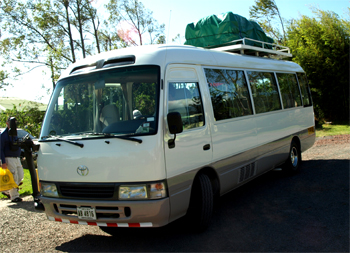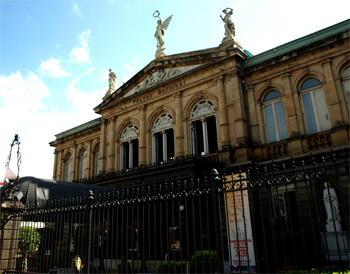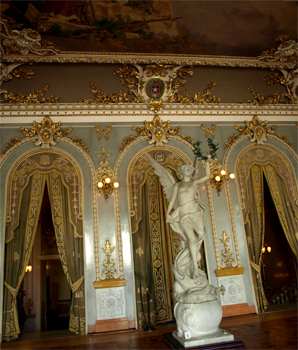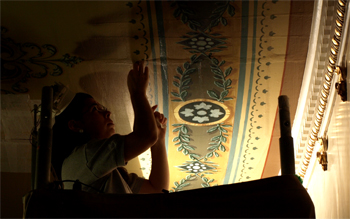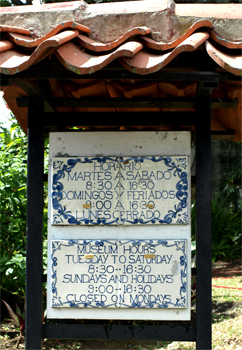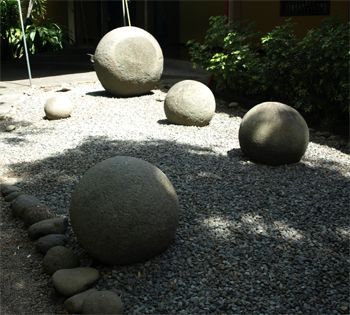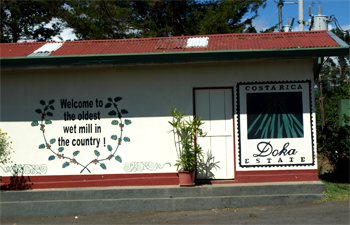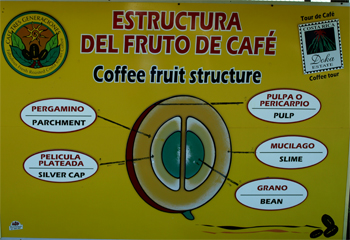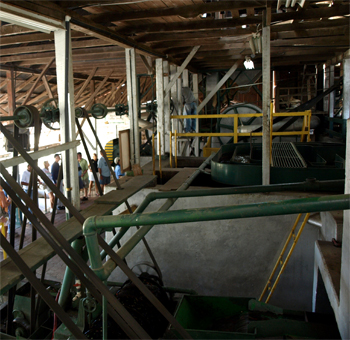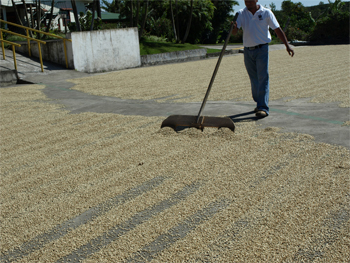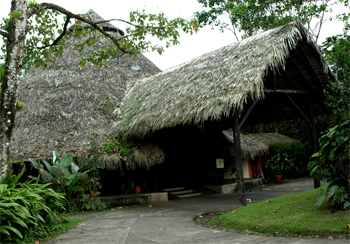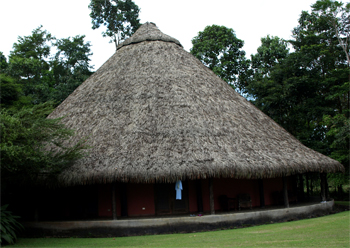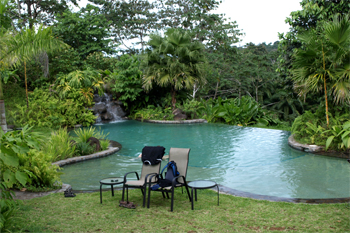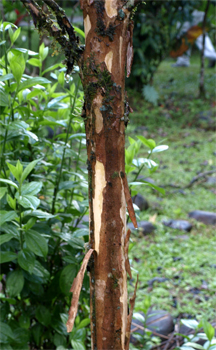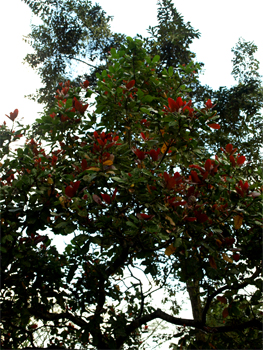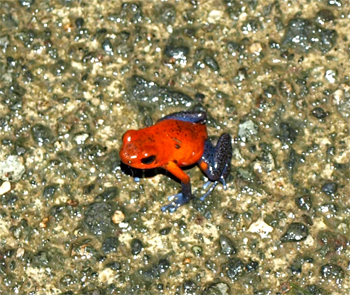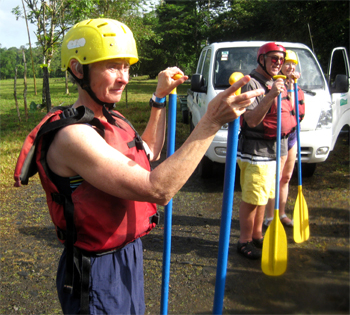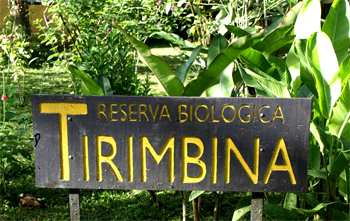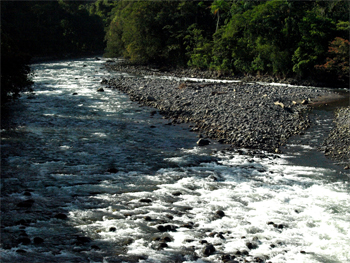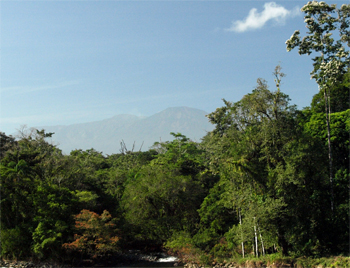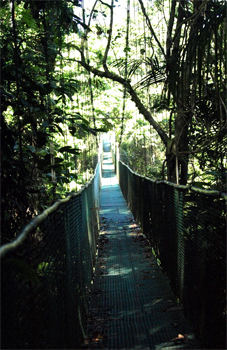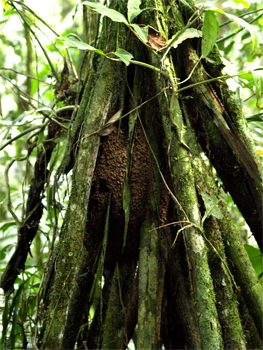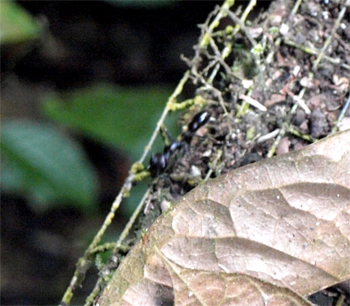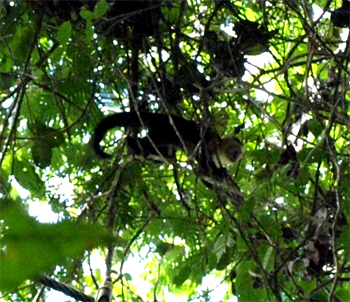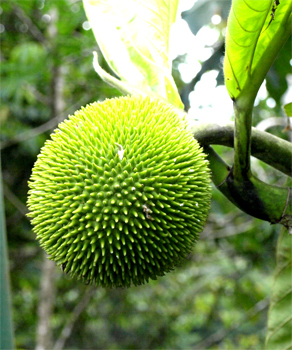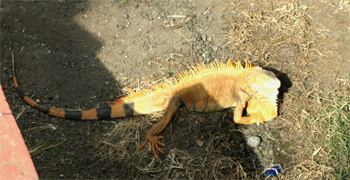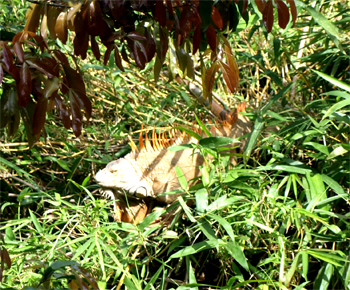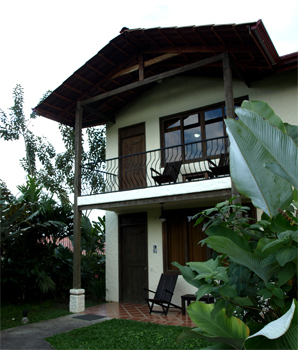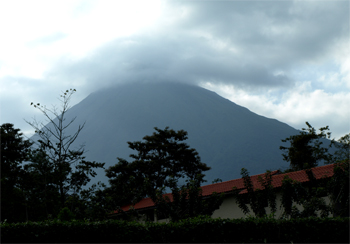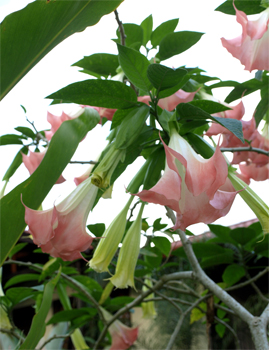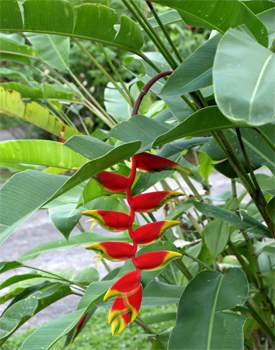OAT - Real Affordable Costa Rica
February 2 - 14, 2010
We were home from the Rose Parade Rally for about two weeks before we headed off for our Overseas Adventure Travel trip to Costa Rica. Had a great time. It is a very nice place to visit - beautiful birds and countryside. Because it is about 10 degrees off the equator, it is pretty hot and humid.
Enjoy the pictures and descriptions.
Tuesday, 2/2/10 - Estes Park to San Jose, Costa Rica
We got up before 5 AM and left for the airport by 6:15. We flew Delta to Atlanta with no problems, had a three-hour layover in Atlanta, and boarded our plane to Costa Rica for an on time departure. We taxied for a long time and then had to return to a gate because someone in first class “felt ill.” The paramedics got on and removed him and then we had to wait until they found his luggage and removed it from the plane. This process delayed us an hour and 15 minutes. We arrived in San Jose, CR at 11:45 PM (CST). We went through immigration and customs without a hitch, were met at the exit by an OAT (Overseas Adventure Travel) representative, and transported to our hotel - Clarion Amon Plaza Hotel. We were the last of our group to arrive.
Wednesday, 2/3/10 - San Jose to Sarapiqui
The breakfast buffet at the hotel was very nice. At 8 AM we met for an orientation and at 9 AM the 16 of us - five couples from Oyster Creek, Englewood, FL, a couple from Brooklyn, and a couple from Toronto. It seems like this will be a fun and active group.
|
Our chariot for the duration of the tour
|
Our first tour stop was at the National Theater of which the Costa Ricans are very proud. It was built around 1900 from a 10% coffee export tax and private donations and is beautiful and elegant. The marble (pink, white and gold), the gold leaf, and the furniture were all imported. The parquet floors are of varieties of local, indigenous woods. The ceiling paintings were done by an Italian artist. The Costa Rican scene in the foyer (it is also in color on their 5 colones bill) is interesting because of the artistic liberty taken by the painter. Coffee trees do not grow at beach level altitude, a man is carrying a hand of bananas upside down and would be covered with sap, and the clothes the women are wearing are out of period. However, it incorporates the essence of Costa Rica. The theater has a men’s entrance on the left and women’s on the right. The main floor rises to stage level for dances and lowers about four feet for symphony performances. The chandelier is lowered by chains to clean each part. The royal box is loge level in the center back and on either side of the stage are four “widows” boxes. Ladies in mourning could attend performances without having to socialize with society. The “teatro” had to be restored after the earthquake of 1992 and the paintings are still being worked on. There are free performances weekdays at noon.
|
|
National Theater exterior |
National Theater interior
|
National Theater restoration in progress |
Square in front of the National Theater
|
The next stop was at the National Museum, which is housed in the Bellavista Fortress, an old military barracks and police station. The ancient stones, precious metals, and pottery displayed at the museum were found at various Costa Rican archeological sites and are similar to those in Mesoamerica and South America.
Also on display is the huge stone spheres, the largest was about ten feet in diameter. There is a theory that those who made and placed the Easter Island heads also sculpted these on an island 18 miles out in the Pacific and placed them here in orientation with the sun, moon, and/or stars.
|
Museum Sign
|
|
Stone sphere artifacts |
We traveled on our minibus (with our luggage strapped to the top) to a Coffee Plantation (Doka Estates, 1919) for lunch and an informative tour. We had a buffet served on a plank of wood covered with a banana leaf. It was an interesting touch. The food was good - especially the soup and coconut candy desert.
Doka Estates
|
|
We were shown what the coffee cherries (the red berries) are like with husk, pulp, parchment, and bean. We walked through the sheds where the old original machines sorted, cleaned, and dried the beans and watched the process in action. The beans can be stored for two years in the husk that enhances the flavor. The husks are removed before they are shipped to reduce the weight. The beans are shipped to Starbucks, Maxwell House, etc where they are roasted. The beans picked green at the end of the season are used to make instant coffee only. Some beans are sent to Germany to go through a decaffeinating process for free. The decaffeinated beans are returned to CR to be sold and Germany keeps the caffeine and sells it to Coke, Pepsi, Red Bull, etc. Did you know it takes about 70 coffee beans to make one cup of coffee? The coffee cherry pulp is fermented and alcohol is added to make coffee liqueurs like Baileys and Kahlua.
|
Washing and sorting the beans |
Shed for big machinery
|
Beans are spread out to dry and turned over several times per day |
After sampling coffees (Peaberry is their best premium coffee) and liqueurs and chocolate covered beans, we headed across the Continental Divide and through the cloud forest at Parque Nacional Brauilio Carillo to Sarapiqui. The road was impressive - winding and steep, up then down. It links the east with west and central CR.
We arrived at our lodge, Sarapiqui Rainforest Lodge, and had a free hour before dinner. It even rained a little for us this evening. The grounds are well groomed with flowering trees and bushes. Dinner was a nice buffet - rice and beans, mashed potatoes, squash, chicken, pork, salad, and rum cake.
Sarapiqui Rainforest Lodge - Lobby and Dining Room
|
Sarapiqui Rainforest Lodge - Our "building" |
Sarapiqui Rainforest Lodge - the pool
|
Our rooms are unique. The eight rooms are in a circle with a common beehive roof and foyer. There is no air conditioning but the ceiling fan helps some and it is hot and humid which is to be expected because we are in the middle of a rainforest and at 10 degrees of latitude.
|
This morning at 6 AM we joined Leo (our OAT tour guide) for a walk through the botanical gardens at our lodge. He pointed out several colorful birds: orioles, fly catchers, canaries, the brown robin - which is the national bird of Costa Rica. They chose this dull colored bird over all the colorful ones because it is like a rooster in rural areas. The robins wake up and fly around chirping every morning between 5 and 5:30, better than an alarm clock!
Torch Ginger
|
Cinnamon Tree - the bark is striped off for the spice |
Cashew tree - its oil can give you the same allergic reaction as poison ivy
|
Blue leg frog |
After breakfast - scrambled eggs, rice and beans, fry bread and fruit - we bused to Hacienda Pozo Azul and went for a five- mile white water raft ride down the Sarapiqui River. There were only one and two category rapids but it was fun. The weather was perfect, partly cloudy so we did not fry and the air and water temperatures were just right. We saw more birds and our guide told stories when we weren’t paddling.
Listening to safety instructions
|
Ready to push off |
We ate lunch at the Hacienda and sat on the veranda watching the river and kids playing in it. It was peaceful and picturesque.
We had planned to take the pineapple farm excursion this afternoon, but since only Marge and I wanted to go, Leo had to cancel it. We rested, swam, wrote, read, and repacked instead. And we also tried to dry our wet bathing suits in this humidity!
Before dinner, six of us joined Leo for a tour of the museum of indigenous people housed here at the reserve. The displays showed the location of the several tribes and then had exhibits of the masks the different cultures used to make and now are relearning to do. They are also making the hollow branches with pebbles inside that shift when turned over and sound like running water. The women make unique net bags and all are being sold as cultural souvenirs.
Dinner was good as usual - another buffet with roast beef and chicken legs. At 7:30 we attended an informative session on local bats. We have realized that this eco-lodge supports several projects. The museum preserves and educates about some of the local culture, the 640 acre private preserve across the adjacent Sarapiqui River has monkeys, tapirs, and sloths as well as many rain forest trees and plants, the botanical garden grows examples of many useful trees and plants, and the education center hosts groups of school kids (all expenses paid for two days and one night) to teach them about nature and ecology.
The biologists at the nature center are studying bats. They put out nets so fine that the bats can’t sense them so they fly into them and are temporarily trapped in net pockets. The bats are identified, measured, counted, and then released. We watched a video on bats feeding, a power point presentation on everything about bats, and then got to look at and even touch two of the fruit eating bats caught this evening. Their ears, nose “leaf,” and little teeth make them look like gargoyles. Their wings are fascinating. When a flashlight is held beneath the spread wing, we could see the blood vessels, finger and arm bones, and scars from injuries.
At the end of our lecture, Willie (the lecturer) took us outside to see the bats released. I have a new respect for bats and where they hang during the day. Since there are no bat caves in CR, some bats chew a banana leaf and make it flop into a tent, and some were hanging from the ceiling of our reception and dining area. |
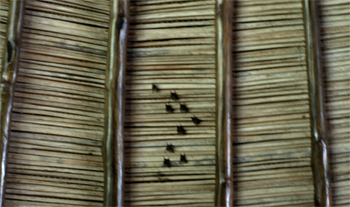 |
Friday, 2/5/10 - Sarapiqui to La Fortuna near Arenal Volcano
After breakfast we took a 2 ½-hour “hike/nature walk” in the preserve at this resort. We started by crossing a 200-yard swinging bridge over the Sarapiqui River. It was hard walking for me and not one of Marge’s favorite activities! From the middle of the river we could see the Poas Volcano. It was a very clear morning and already hot at 8 AM.
|
Sarapiqui River
|
Poas Volcano in the distance
|
Long swinging bridge over the Sarapiqui River
|
An adventurous suspension bridge
|
Walking stick tree with ant nest |
Bullet ant - do not let it bite you!
|
Spider in its web |
The prepared trail made it fairly easy to walk through this “secondary” rain forest. The trees of the first forest were cut down for lumber and a second forest grew up. The difference is that there are many plants growing at ground level whereas in the true old rain forest, no light hits the ground to support low plants. We saw many “walking” trees that send out new roots from the trunk above the old rotting ones. The new roots pull the tree toward light. The tree moves in this way to stay in a patch of light.
|
|
Capuchin monkey in the forest canopy |
Fruit of the noni tree
|
It was an interesting walk with lots of diversity. Sometimes we were up in the canopy on swinging bridges and sometimes down at ground level. It is interesting how uniquely these plants and critters adapt to their environment.
Back at our compound, we had time to relax and pack up for our next move. After lunch - the treat was a scoop of ice cream (vanilla with small chips of chocolate) for dessert - we boarded the bus and headed to the town of La Fortuna near the active Arenal Volcano. We made a “discovery” stop at a village to look at iguanas. One shopkeeper feeds them with restaurant scraps and it keeps dozens of the large iguanas content to stay nearby. It is a touristy thing and of course, you can get an ice cream cone or coffee or souvenirs next to the viewing area.
Iguana |
Another iguana
|
We drove on through La Fortuna to our fancy resort, Casa Luna. We settled in after a fruity welcome drink. We walked the grounds and Marge took pictures of datura, bamboo orchids, and lobster claws. The landscaping here is very nice. We can see the volcano from the grounds; the greenery blocks the view from our window. We saw another toucan but he was too far away for a picture.
Casa Luna Lodge
|
Casa Luna Lodge grounds |
Arenal Volcano |
Bamboo Orchid
|
Datura |
Lobster Claw
|
Our drive today was through lush forest and then cattle and dairy ranches. We enjoy seeing the country and how the environment changes.
| Return to Top | Return to Costa Rica Itinerary | Return to Dreamcatcher Home Page |

